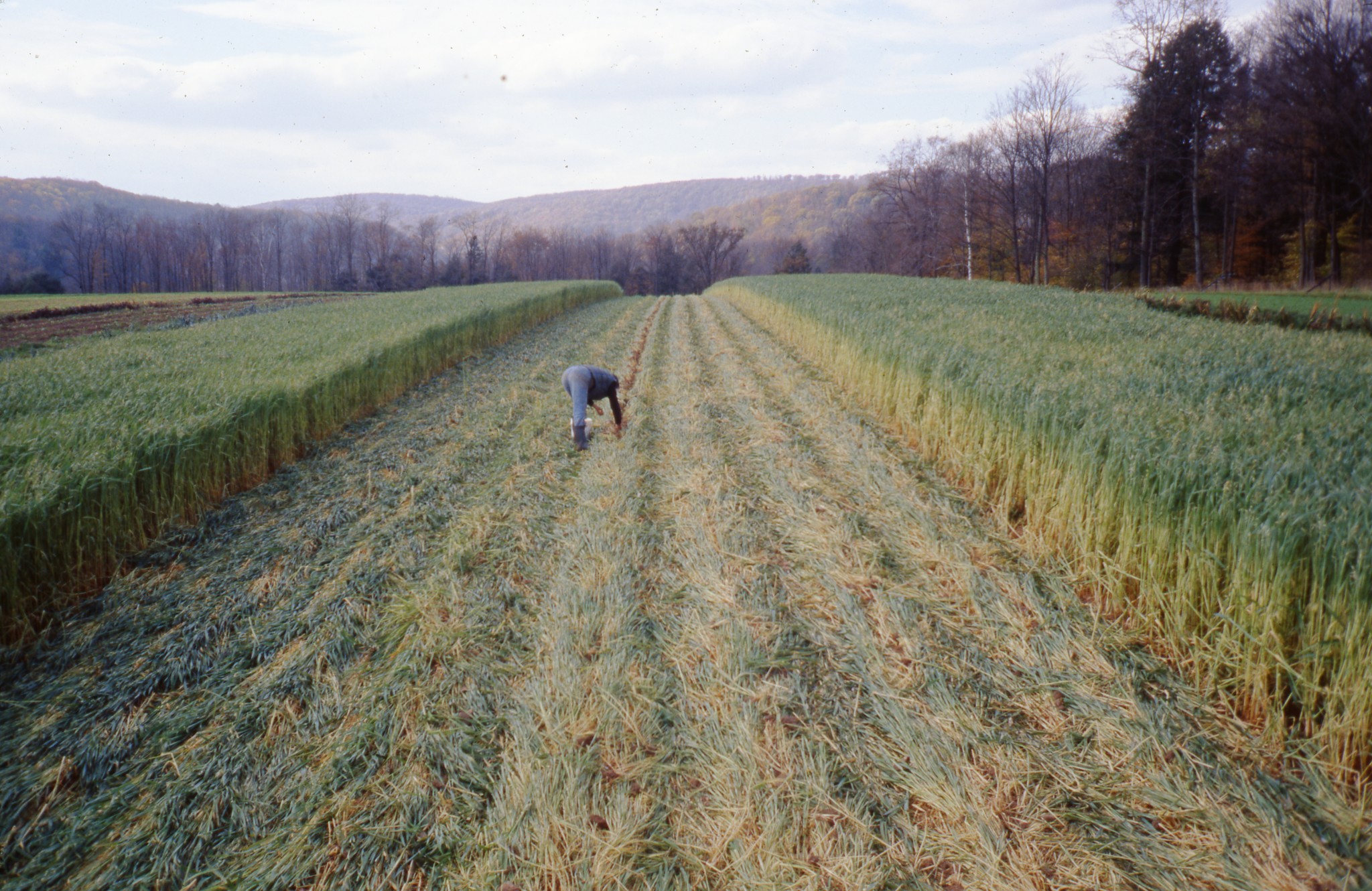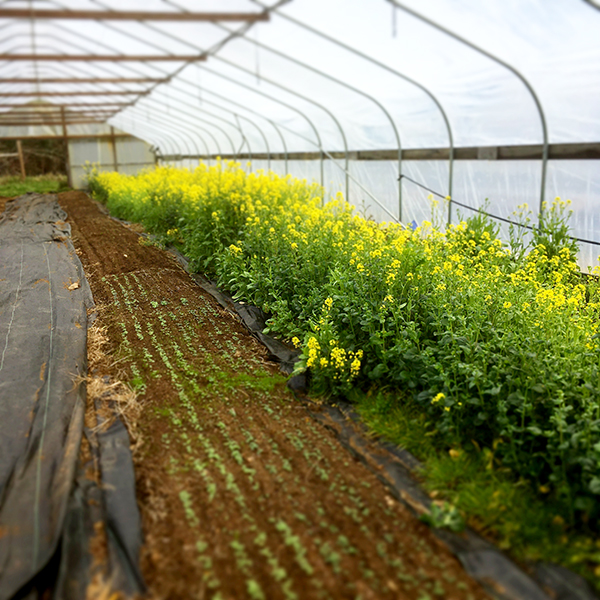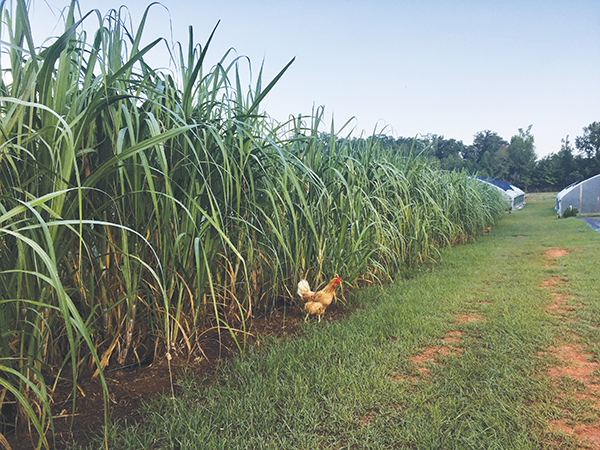By Anne and Eric Nordell
When we started farming in 1983, there were few models of organic, horse-powered market gardening. So we used the traditional practices for growing field crops here in north-central Pennsylvania, preparing a seedbed with the moldboard plow, spring tooth harrow and cultipacker. We quickly realized we needed to put a whoa on moldboard plowing to dependably establish dryland produce.
Deep plowing dried out the soil surface too much for transplanting or direct seeding without irrigation or timely rainfall. Shallow tillage, on the other hand, preserved surface soil moisture by concentrating the organic matter from the cover crops and our limited supply of horse manure compost in the top two to three inches of the soil. Reducing the depth of soil disturbance also enhanced subsoil moisture movement to the surface via capillary action while the soil/cover crop mulch on top slowed evaporation.

Initially, we adjusted the moldboard plow to turn a furrow just a few inches deep. Over time, we added other forms of minimum-depth tillage, such as mulch-tillage, ridge-till, zone-till and no-till, learning through trial-and-error which type of reduced tillage worked best for each type of vegetable.
For instance, no-tilling into an oat cover crop turned out to be ideal for fall-planted garlic because this allium likes the cool moist soil under a blanket of winter-killed residue and is more slug tolerant than other market garden crops. Spring planted alliums, such as onions and leeks, seem to do better if the winter-killed cover crop is lightly tilled before planting, perhaps benefitting from soil warming and increased biological activity. Direct seeding carrots, beets, spinach and salad mix is much easier if we surface till the cover crop reside for an extended period to allow it to decompose. Or we remove the cover crop top growth for mulching adjacent crops, such as the alliums or long-term fruiting vegetables, like winter squash.

For the latter method, the side delivery hay rake has become one of our most important whoa-till tools, an idea we learned from Chilean no-till pioneer Carlos Crovetto. We mow the small grain cover crops when headed out, then rake the long stem straw into windrows for mulching. Removing the cover crop topgrowth allows the soil to warm up and dry out quickly for spring planting and reduces slug habitat. The short stubble is also easy to till shallowly with a spring tooth harrow or cultivator.
We should not give minimum-depth tillage all the credit for being able to establish vegetables without irrigation. Our silt-loam soil has decent moisture holding capacity which we have improved by taking half of the market garden out of production each year for growing cover crops. Strategic tillage and stale seedbedding during these fallow years has virtually eliminated moisture robbing summer weeds. We enjoy a relatively cool, short growing season at our 1600’ elevation. Annual average rainfall is 42”, although precipitation can be erratic, swinging from prolonged periods of wet to dry weather.

To compensate, we grow all of our vegetables, even short-term greens, in widely-spaced single rows. We started out row cropping produce so we could use the traditional horse-drawn riding cultivators manufactured a hundred years ago for cultivating corn. We stuck with row cropping because it provides a much larger reservoir of moisture per plant than intensive production in multiple-row beds. Widely spaced rows also make it easier to cultivate vegetables planted in a lot of moisture-conserving cover crop residue.
We have not realized the superior soil quality, moisture infiltration and erosion control of permanent no-till systems for two, so far, inusurmountable reasons. Blown-in dandelion seeds, quackgrass encroaching from the field edges, and winter weeds growing in the cover crops necessitate timely cultivation or tillage. The cover crops also take a lot of moisture out of the soil requiring us to kill them a minimum of six weeks before planting to insure we receive at least one moisture-restoring rain before direct seeding or transplanting. Winter killed or mower killed cover crops can satisfy this timeline for a few planting windows, but to guarantee enough soil moisture for successive plantings of lettuce, salad mix and spinach all summer long, we resort to shallow tilling many of the overwintering cover crops.


Another barrier to permanent no-till is our choice of horsedrawn equipment. Although Amish shops are now manufacturing and retrofitting no-till drills and planters, we cannot justify the price for a few acres of produce and are not sure how practical these implements would be for many small plantings of a wide variety of vegetables. Instead, we have collected a fleet of old riding cultivators, costing from $0 to $200, which we have set up for different types of minimum-depth tillage and cultivation. The cultivators also help out with planting by opening up a narrow furrow for transplanting by hand or preparing a suitable seedbed for the walk-behind seeder.
The major drawback of these old cultivators is that the lifting mechanism is operated manually, limiting the amount of downpressure or added weight we can use for no-tilling into a cover crop. We get around this by planting some of the cover crops on ridges. The soil remains loose and soft enough in the cover cropped ridges to use these lightweight implements to open up a no-till planting furrow. The ridges enhance soil warming, aeration and drainage, while adding cover crop mulch to the valleys insures long-term moisture preservation.

In our experience, the two big challenges to growing whoa-till vegetables is waiting until both the soil and residue are fit to commence planting, and managing the cover crops so they do not harbor herbivores, like slugs and rabbits. Although minimum-depth tillage has made it possible to reliably establish vegetables without irrigation, extended drought conditions can affect yield and quality. Nevertheless, our farm income has been remarkably consistent despite the weather extremes in recent years, and our customers rave about the flavor of our dryland produce.
More details on alternative horsedrawn tillage and weed management can be found in the Nordells’ “Cultivating Questions” column in The Small Farmers Journal, recent issues of Rural Heritage, and their “Weed the Soil, Not the Crop” video and booklet. The DVD costs $15 plus $3 S&H; the booklet is $10 plus $3 S&H. Please send payment to Anne or Eric Nordell, 3410 Rt 184, Trout Run, PA 17771.

 In 2013, Cameron and Audrey Pedersen relocated Bending Bridge Farm to twelve acres of land they purchased near Chambersburg, PA. Given their new land had been in continuous conventional corn production for decades, the soil was in dire shape. The first spring working that ground they could not even get a chisel plow to break the surface because the soil was so compacted and crusted.
In 2013, Cameron and Audrey Pedersen relocated Bending Bridge Farm to twelve acres of land they purchased near Chambersburg, PA. Given their new land had been in continuous conventional corn production for decades, the soil was in dire shape. The first spring working that ground they could not even get a chisel plow to break the surface because the soil was so compacted and crusted. 


 If you’ve been a subscriber to Growing For Market (or even if you haven’t), you’re probably familiar with the many advantages of no-till agriculture. No-till methods can reduce a farm’s carbon footprint, promote complex soil biology, and preserve and build organic matter.
If you’ve been a subscriber to Growing For Market (or even if you haven’t), you’re probably familiar with the many advantages of no-till agriculture. No-till methods can reduce a farm’s carbon footprint, promote complex soil biology, and preserve and build organic matter.
 It only took me a few minutes to decide to put the Beech Grove Farm Fall Tour on my schedule upon seeing the advertisement in a Pennsylvannia Association for Sustainable Agriculture (PASA) e-blast. Visiting this horse-powered vegetable operation has been on my farm “bucket list” for many years. I hold Anne and Eric Nordell as some of my most highly respected farm heroes.
It only took me a few minutes to decide to put the Beech Grove Farm Fall Tour on my schedule upon seeing the advertisement in a Pennsylvannia Association for Sustainable Agriculture (PASA) e-blast. Visiting this horse-powered vegetable operation has been on my farm “bucket list” for many years. I hold Anne and Eric Nordell as some of my most highly respected farm heroes. 



 My wife, Megan, and I grow cut flowers on half an acre of a twelve-acre property in Hurdle Mills, NC. We are in the heart of tobacco country. When we bought our property in 2013, our sales contract stipulated that the farmer had the right to harvest that year’s tobacco crop. Based on our best guesses, that marked at least the 100th consecutive year of tobacco/wheat rotations on this property. The farmer was kind enough to disc in the tobacco stubble after the harvest.
My wife, Megan, and I grow cut flowers on half an acre of a twelve-acre property in Hurdle Mills, NC. We are in the heart of tobacco country. When we bought our property in 2013, our sales contract stipulated that the farmer had the right to harvest that year’s tobacco crop. Based on our best guesses, that marked at least the 100th consecutive year of tobacco/wheat rotations on this property. The farmer was kind enough to disc in the tobacco stubble after the harvest.
 Julia Asherman appeared on my radar screen a number of years ago because she was a regular presence at the Southern Sustainable Agriculture Working Group conferences where I’ve spoken many times. Colleagues pointed her out to me as a person to watch because she was tough and smart and she was going to make something of herself as a farmer. We became conference buddies. So, when I had the good fortune to get invited to speak at the Georgia Organics Conference in Athens this winter, I knew right away I wanted to take that opportunity to visit Julia at her place, Rag & Frass Farm in Jeffersonville, Georgia.
Julia Asherman appeared on my radar screen a number of years ago because she was a regular presence at the Southern Sustainable Agriculture Working Group conferences where I’ve spoken many times. Colleagues pointed her out to me as a person to watch because she was tough and smart and she was going to make something of herself as a farmer. We became conference buddies. So, when I had the good fortune to get invited to speak at the Georgia Organics Conference in Athens this winter, I knew right away I wanted to take that opportunity to visit Julia at her place, Rag & Frass Farm in Jeffersonville, Georgia.
 Farmer to Farmer Profile
Farmer to Farmer Profile
 In the mid-1980s I had a farm in upstate New York and grew 20 acres of organic vegetables with machinery. It was organic, but not sustainable both for the use of fossil fuel and high level of personal burnout. I lost my joy of farming and never thought I would go back into it for my livelihood.
In the mid-1980s I had a farm in upstate New York and grew 20 acres of organic vegetables with machinery. It was organic, but not sustainable both for the use of fossil fuel and high level of personal burnout. I lost my joy of farming and never thought I would go back into it for my livelihood.
 There are good reasons why quick-growing greens crops have gotten a lot of attention in no-till systems. But I wanted to try growing some less common no-till crops, so I grew test plots of potatoes and sweet potatoes on my farm this past year.
There are good reasons why quick-growing greens crops have gotten a lot of attention in no-till systems. But I wanted to try growing some less common no-till crops, so I grew test plots of potatoes and sweet potatoes on my farm this past year.